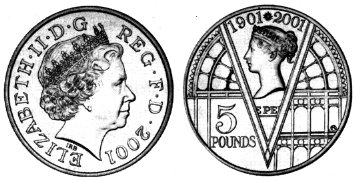
Crystal Jewel in Victoria's Crown
New Coin Remembers Crystal Palace
To mark the 100th anniversary of the death of Queen Victoria, the Royal Mint has issued a commemorative coin featuring her profile mounted on the unmistakable outline of Crystal Palace.

The arched iron framework at the southern end of the palace was the angle chosen to exemplify the building, constructed to house the Great Exhibition of 1851 and so to symbolise the apex of the Victorian era (1837-1901).
Coincidentally, the launch of the coin came in mid May - the same time as hundreds of campaigners were relieved to hear a stay of execution had been given to the development of a controversial multi-million pound leisure complex.
The news was followed last week with the announcement that pressure group the Ridge Wildlife Group is hoping to keep the site open for residents and to protect its wildlife.

The Crystal Palace stood in Hyde Park before it was moved and reconstructed on its present site and opened by Queen Victoria on June 10, 1854, when it became a 200 acre theme park.
In 1911, the year of King George V's coronation, the palace was home to the Festival of Empire. Three-quarter size models of the parliament buildings of empire and commonwealth countries were erected in the grounds to contain exhibits of each country's products.
It was originally conceived and organised by Victoria and her husband Price Albert, to symbolise the industrial, military and economic success of Britain.
They decided to make the exhibit truly international with invitations being extended to almost all of the colonised world.
The Queen was eager to preserve the prevailing feeling of contentment with her reign - it was during the mid 1850's that the word Victorian was first used to express the new self-consciousness.
Sir Joseph Paxton was employed to design it and within 10 years he had imagined it would take the form of a huge iron Goliath with over a million feet of glass.
Over 13,000 exhibits were displayed and viewed by more than six million visitors to the exhibition.
Among the exhibits was the Jacquard loom, an envelope machine, tools, kitchen appliances, steel-making displays and a reaping machine from the United States, Profits allowed for the foundation of public works such as the Albert Hall, the Science Museum, the Natural History Museum and the Victoria and Albert Museum.
The Building was divided into themed courts tracing the history of art and architecture from ancient Egypt via the Renaissance, as well as exhibits from industry and nature.
Concerts were held in the centre transept, which also contained the world's largest organ.
The area also housed a circus in which daring performances by world-class stunt acts like the tightrope walker Blondin were shown.
The world's first aeronautical exhibition was held at the palace in 1868 and the first national motor show, plus cat, dog, pigeon, honey and flower shows.
The Crystal Palace itself was almost outshone by the surrounding park, which contained fountains powered by 12,000 individual jets.
There were also collections of statues, many of which were copies of great works from around the globe, and a geological display including a replica lead mine and the first attempts anywhere in the world to portray life-size restorations of extinct animals, including dinosaurs, which currently feature in Bromley Council's restoration plans.
On November 30, 1936, as the palace stood in its present surroundings, it was destroyed by fire. Following this the area lost much of its focus and began to decline.
But many of the most important events in the history of the Crystal Palace took place in the grounds, which in recent years have been the focus of ongoing friction between the council and local heritage groups.
Nonetheless it remains a much cherished Grade II listed historic park.